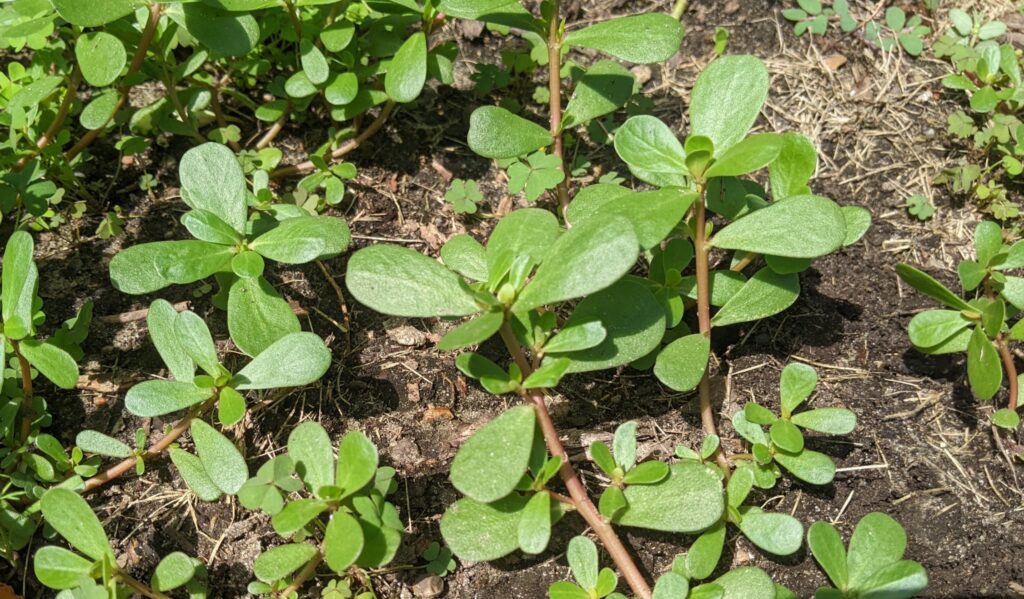This heat-loving weed is tricky to control. Chop it with a hoe and any scattered bits will each propagate into an entire new plant. So instead, use the following tricks.

Purslane is a pretty plant, a succulent that resembles a miniature version of the popular houseplant, the jade plant. And you can also eat purslane like a salad green–it has a bitter flavor that makes me think of arugula.
But for all its assets, purslane is a nasty weed. Purslane shows up in my Iowa garden in summer when the temperatures start hitting the 90s, wherever it can get full sun. It will grow in a variety of soils, but seems to love rich, loose soil the most.
Don’t Hoe!
The most important thing to remember about purslane is to avoid hoeing or tilling it or in any way breaking it up. This simply disperses bits of the plant through the soil. Then each tiny bit of leaf or root will grow into an entirely new plant—not unlike the Greek mythological creature, the Hydra. Cut off one of this snake-like creature’s several heads and two more would instantly sprout out in its place!
So pulling (not hoeing) the weed is your first line of offense. Purslane has spreading stems originating from a central taproot, so weed only with then soil is moist and loose enough to also get the taproot. However, purslane will rapidly come back. Also, it likes nestling into tight spots between flagstones, making it tough to pull effectively.
But the one thing purslane does not like is deep shade, and you can use this to your advantage. Seeds from purslane can live in the soil for up to 40 years, but not unless they are in the top half inch or so of the soil. (Another reason tilling and hoing are ill-advised for this weed. It just brings the weed seeds to the soil surface where they can germinate.)
Mulch It!
After pulling, it’s wise to apply a thick layer of mulch to suffocate and shade out the plant. After pulling out any purslane taller than a half-inch, spread up to 3 inches of just about any type of loose, organic mulching material, such as grass clippings, newspaper, or bark mulch.
Another effective way to control it, if you choose to use synthetic chemicals, is to spray it with Round-Up non-selective herbicide. An organic but less effective organic alternative, straight vinegar, the higher the concentration the better. Spraying doesn’t seem to work well on plants more than a half-inch or so tall, so consider first pulling and then spraying the small bits that remain behind. Be sure to spray on a warm, dry day or the spray will not be effective. And be careful that the spray doesn’t even lightly mist plants you want to keep
Eat it!
Now if you are in the “if you can’t beat ’em then eat ’em” category, you won’t go hungry. There are plenty of purslane plants out there and I’m sure your neighbors would love to share theirs with you. If you are a connoisseur, you can also purchase purslane seeds for the cultivated forms for better flavor and easier harvesting. They tend to grow more upright than the wild types.
With purslane aficionados the preference is in eating fresh young plants, and especially young leaves and tender stem tips. The taste is similar to watercress or spinach. Use purslane in salads or on sandwiches instead of lettuce or pickles. Next time order a ham and purslane on rye. Purslane can also be cooked steamed, stir-fried or pureed. It tends to get a bit slimy if overcooked. It can be substituted for spinach in many recipes. Seeds are also edible.
Harvest only purslane that has not been treated with synthetic chemicals. Be sure to wash the purslane thoroughly. As with any new food, don’t over indulge.
— Veronica Fowler, The Iowa Gardener
Please do not use content from this site without express permission from The Iowa Gardener. Click here to request permission.